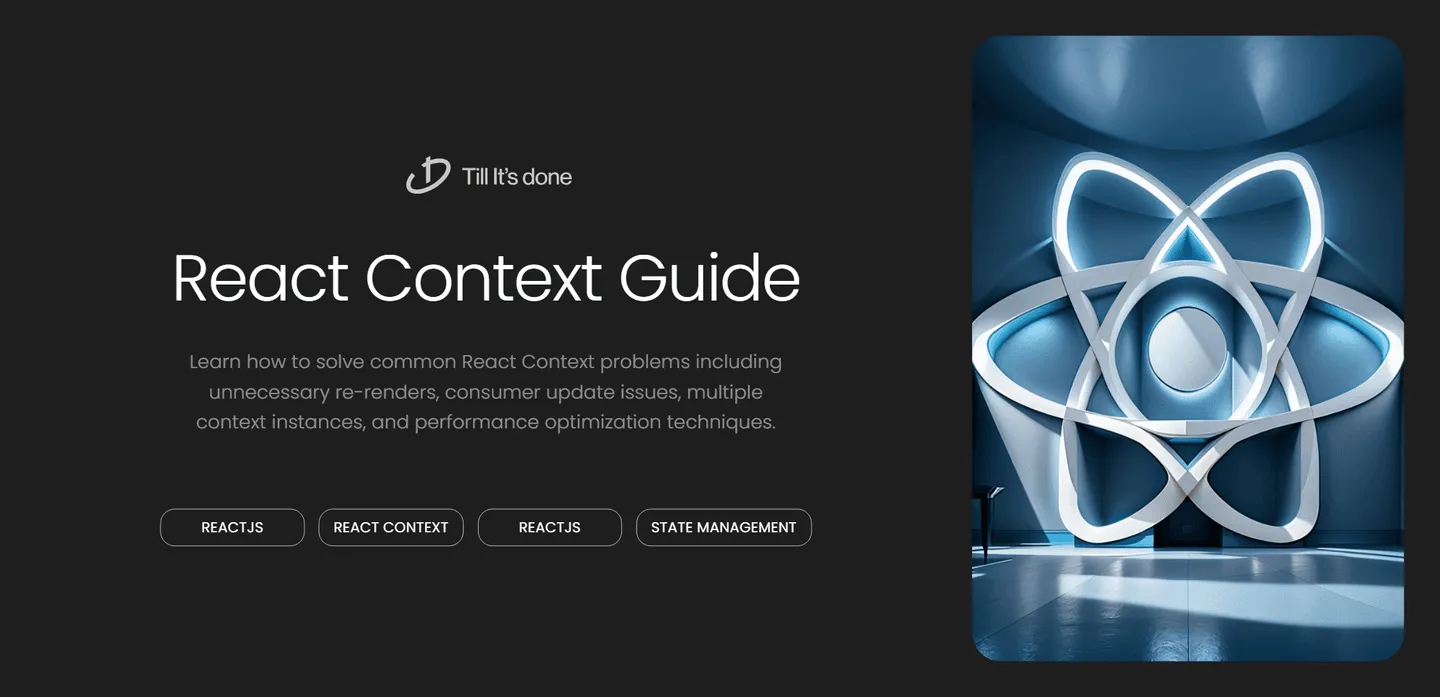- Services
- Case Studies
- Technologies
- NextJs development
- Flutter development
- NodeJs development
- ReactJs development
- About
- Contact
- Tools
- Blogs
- FAQ
Troubleshooting Common Issues with React Context

Troubleshooting Common Issues with React Context: A Developer’s Guide

React Context has revolutionized state management in React applications, but like any powerful tool, it comes with its own set of challenges. As someone who’s spent countless hours debugging Context-related issues, I want to share some common pitfalls and their solutions.
The Context Value Changes Too Often
One of the most frequent issues I encounter is unnecessary re-renders caused by context value changes. This typically happens when we pass a new object as the context value on every render.
Here’s what it might look like:
const MyProvider = ({ children }) => { // 🚫 Bad: Creates new object on every render return ( <MyContext.Provider value={{ user: currentUser, updateUser: handleUpdateUser }}> {children} </MyContext.Provider> );};
The solution? Memoize your context value:
const MyProvider = ({ children }) => { // ✅ Good: Memoized value only changes when dependencies change const value = useMemo(() => ({ user: currentUser, updateUser: handleUpdateUser }), [currentUser]);
return ( <MyContext.Provider value={value}> {children} </MyContext.Provider> );};Context Consumer Not Updating
Sometimes you might find that your components aren’t re-rendering when context values change. This usually happens when you’ve accidentally nested providers incorrectly or when the context value isn’t properly propagating through the component tree.
Make sure your provider wraps the components that need access to the context:
// ✅ Good: Provider wraps all components that need the contextconst App = () => { return ( <ThemeProvider> <UserProvider> <Navigation /> <MainContent /> <Footer /> </UserProvider> </ThemeProvider> );};Multiple Instances of Context
A subtle but frustrating issue occurs when you accidentally create multiple instances of the same context. This can happen when you define your context in a component file instead of a separate module:
// 🚫 Bad: Context created inside componentconst MyComponent = () => { const MyContext = createContext(); // New instance on every render! // ...};
// ✅ Good: Context created as module-level constantconst MyContext = createContext();const MyComponent = () => { // ...};
Default Value Confusion
The default value of createContext() only applies when a component doesn’t have a matching Provider above it in the tree. This can lead to confusion when testing or when components are used in isolation:
const UserContext = createContext(null); // Be explicit about the shape
// Better approach:const defaultValue = { user: null, updateUser: () => { console.warn('UserContext: using default value'); }};const UserContext = createContext(defaultValue);Performance Optimization with Context
Remember that all consumers will re-render when the context value changes. To optimize performance, split your context into smaller, more focused pieces rather than one giant context store. This way, components only re-render when the specific data they need changes.
By keeping these common issues and their solutions in mind, you’ll be better equipped to handle React Context in your applications. The key is to understand how Context works under the hood and follow the best practices consistently.

 สร้างเว็บไซต์ 1 เว็บ ต้องใช้งบเท่าไหร่? เจาะลึกทุกองค์ประกอบ website development cost อยากสร้างเว็บไซต์แต่ไม่มั่นใจในเรื่องของงบประมาณ อ่านสรุปเจาะลึกตั้งแต่ดีไซน์, ฟังก์ชัน และการดูแล พร้อมตัวอย่างงบจริงจาก Till it’s done ที่แผนชัด งบไม่บานปลายแน่นอน
สร้างเว็บไซต์ 1 เว็บ ต้องใช้งบเท่าไหร่? เจาะลึกทุกองค์ประกอบ website development cost อยากสร้างเว็บไซต์แต่ไม่มั่นใจในเรื่องของงบประมาณ อ่านสรุปเจาะลึกตั้งแต่ดีไซน์, ฟังก์ชัน และการดูแล พร้อมตัวอย่างงบจริงจาก Till it’s done ที่แผนชัด งบไม่บานปลายแน่นอน  Next.js สอน 14 ขั้นตอนเบื้องต้น: สร้างโปรเจกต์แรกใน 30 นาที เริ่มต้นกับ Next.js ใน 14 ขั้นตอนเพียงแค่ 30 นาที พร้อม SSR/SSG และ API Routes ด้วยตัวอย่างโค้ดง่าย ๆ อ่านต่อเพื่อสร้างโปรเจ็กต์แรกได้ทันทีที่นี่
Next.js สอน 14 ขั้นตอนเบื้องต้น: สร้างโปรเจกต์แรกใน 30 นาที เริ่มต้นกับ Next.js ใน 14 ขั้นตอนเพียงแค่ 30 นาที พร้อม SSR/SSG และ API Routes ด้วยตัวอย่างโค้ดง่าย ๆ อ่านต่อเพื่อสร้างโปรเจ็กต์แรกได้ทันทีที่นี่  วิธีสมัคร Apple Developer Account เพื่อนำแอปขึ้น App Store ทีละขั้นตอน อยากปล่อยแอปบน App Store ระดับโลก มาอ่านคู่มือสมัคร Apple Developer Account พร้อมเคล็ดลับ TestFlight และวิธีอัปโหลดที่ง่ายในบทความเดียวนี้ได้เลย
วิธีสมัคร Apple Developer Account เพื่อนำแอปขึ้น App Store ทีละขั้นตอน อยากปล่อยแอปบน App Store ระดับโลก มาอ่านคู่มือสมัคร Apple Developer Account พร้อมเคล็ดลับ TestFlight และวิธีอัปโหลดที่ง่ายในบทความเดียวนี้ได้เลย  TypeScript Interface คืออะไร? อธิบายพร้อมวิธีใช้และข้อแตกต่างจาก Type เรียนรู้วิธีใช้ TypeScript Interface เพื่อสร้างโครงสร้างข้อมูลที่ปลอดภัยและเข้าใจง่าย พร้อมเปรียบเทียบข้อดีข้อแตกต่างกับ Type ที่คุณต้องรู้ ถูกรวมเอาไว้ในบทความนี้แล้ว
TypeScript Interface คืออะไร? อธิบายพร้อมวิธีใช้และข้อแตกต่างจาก Type เรียนรู้วิธีใช้ TypeScript Interface เพื่อสร้างโครงสร้างข้อมูลที่ปลอดภัยและเข้าใจง่าย พร้อมเปรียบเทียบข้อดีข้อแตกต่างกับ Type ที่คุณต้องรู้ ถูกรวมเอาไว้ในบทความนี้แล้ว  Material-UI (MUI) คืออะไร อยากสร้าง UI สวยงามและเป็นมืออาชีพในเวลาอันรวดเร็วใช่ไหม มาทำความรู้จักกับ Material-UI (MUI) ที่ช่วยให้คุณพัฒนาแอปพลิเคชันบน React ได้ง่ายและดูดีในทุกอุปกรณ์
Material-UI (MUI) คืออะไร อยากสร้าง UI สวยงามและเป็นมืออาชีพในเวลาอันรวดเร็วใช่ไหม มาทำความรู้จักกับ Material-UI (MUI) ที่ช่วยให้คุณพัฒนาแอปพลิเคชันบน React ได้ง่ายและดูดีในทุกอุปกรณ์  เปรียบเทียบ 3 วิธีติดตั้ง install node js บน Ubuntu: NVM vs NodeSource vs Official Repo แบบไหนดีที่สุด? เรียนรู้วิธีติดตั้ง Node.js บน Ubuntu ด้วย NVM, NodeSource หรือ Official Repo เลือกวิธีที่เหมาะกับความต้องการของคุณ พร้อมเปรียบเทียบ เพื่อการพัฒนาที่มีประสิทธิภาพ!
เปรียบเทียบ 3 วิธีติดตั้ง install node js บน Ubuntu: NVM vs NodeSource vs Official Repo แบบไหนดีที่สุด? เรียนรู้วิธีติดตั้ง Node.js บน Ubuntu ด้วย NVM, NodeSource หรือ Official Repo เลือกวิธีที่เหมาะกับความต้องการของคุณ พร้อมเปรียบเทียบ เพื่อการพัฒนาที่มีประสิทธิภาพ! Talk with CEO
We'll be right here with you every step of the way.
We'll be here, prepared to commence this promising collaboration.
Whether you're curious about features, warranties, or shopping policies, we provide comprehensive answers to assist you.


